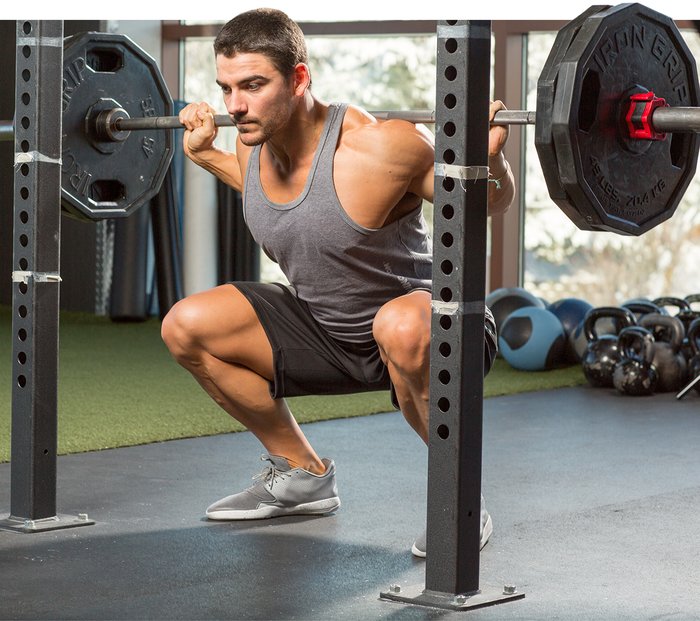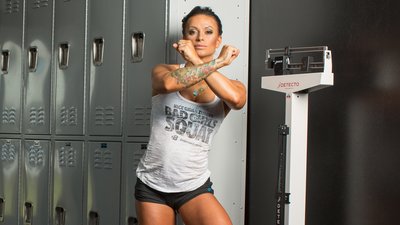People often consider the scale the holy grail of weight loss. They hop on, stare at the number, then measure their daily, weekly, or monthly progress by how quickly that number changes.
While it's fine to have an idea of where you stand, relying solely on the scale is a mistake. From fluctuations in water weight to lean-mass gains, weight doesn't tell the entire story. Instead of obsessing over the scale, take the well-rounded approach by implementing these five other ways to track your progress.
1. Take Progress Photos
As uncomfortable as it might be to snap a photo when you feel out of shape, less than stellar, or downright schlubby, knowing where you started is essential. It's easy to let the scale rule, but when you consider things like water weight, lean-mass gains, and bodyweight distribution, relying on a single number to decide if you're headed in the right direction seems arbitrary. Since you see yourself in the mirror daily, changes can be nearly imperceptible.

Photos give you that necessary degree of separation—allowing you to take a step back and reflect weeks later. When you start your fitness journey, begin by taking photos of your front, side, and back. Every few weeks, take additional photos. If you're looking for accuracy, there's no need to suck in your gut or push your stomach out. Just stay relaxed, and keep the conditions the same to most accurately reflect your visual progress over time. This means wearing the same outfit, taking photos at the same time of day, and using the same angles and lighting.
2. Retest Your Benchmark Lifts
Instead of relying solely on reducing numbers, try increasing them—in the form of weights, that is. When you kick off your journey, take some time to test your strength benchmarks. How much can you press and pull? What do your squat numbers look like? By having a ballpark idea of your strength baseline, you'll know what achievable numbers to aim for.

You'll also be able to set incremental goals that help keep you on track. Apps like BodySpace make it easy to plug in the weight used for a specific amount of reps and sets. Tracking your progress ensures you're headed in the right direction. Bonus: If you plateau, looking back at where you started can give you the motivation needed to ramp up your numbers once again.
3. Use a Tape Measure
You might take dipping numbers on the scale as an indication of progress, but not all weight loss is fat loss. To see if you're leaning out, a tape measure can be a more effective tool. Some areas you might want to track the inches on include your chest, hips, waist, thighs, biceps, and shoulders.

Knowing your measurements could do more than just help you build a proportionate physique. Where you store the majority of your fat can also serve as a warning sign for complications related to obesity—including diabetes, stroke, and heart disease. A study in the European Heart Journal, for example, found that both waist-to-hip ratio and waist circumference were positively associated with heart disease risk.[1] Women with a waist-to-hip ratio of above 0.85 and men with one greater than 0.90 have a higher risk.
4. Measure Your Body Fat
Just a little pinch can tell you a bit about your weight loss progress. Skinfold measurements estimate body fat percentage based on the amount of fat you have lying right underneath the skin. While results might be off by as much as 6 percent, using the same method every time and looking at the percentage-lost trend—rather than strictly at the number—can help you track your fat-loss progress.[2]

5. Try on Your Old Clothing
When you've been living the fit life for a while but feel you've plateaued, trying on old clothes can help you regain perspective. Maybe you didn't hit that 100-pound weight-loss goal in a year, but you're swimming in your "fat jeans." That's progress!
By redefining progress, and broadening your view beyond the numbers, you'll set yourself up for success—even when the scale's numbers waver.
References
- De Koning, L., Merchant, A. T., Pogue, J., & Anand, S. S. (2007). Waist circumference and waist-to-hip ratio as predictors of cardiovascular events: meta-regression analysis of prospective studies. European Heart Journal, 28(7), 850-856.
- Peterson, M. J., Czerwinski, S. A., & Siervogel, R. M. (2003). Development and validation of skinfold-thickness prediction equations with a 4-compartment model. The American Journal of Clinical Nutrition, 77(5), 1186-1191.

